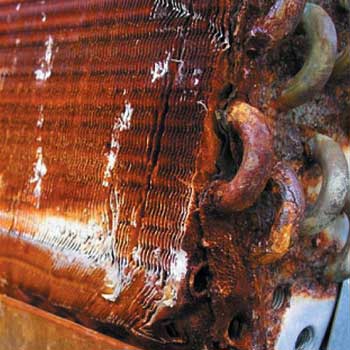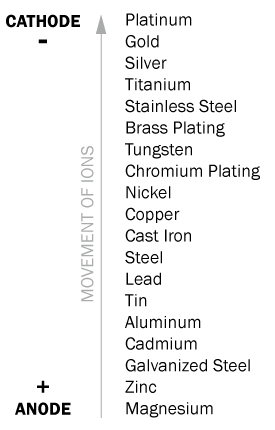Get Tech Tips
Subscribe to free tech tips.
That Rusty Coil/Galvanic Corrosion

How many times have you looked at the bottom right-hand side of an evaporator coil and seen all sorts of rust, even on a fairly new coil?
You may have noticed that many evaporator coils and even some condenser coils will start to corrode where the galvanized steel endplates touch the copper u-bends of the coil. This is a common example of “galvanic corrosion,” and it occurs anytime two different (dissimilar) metals come into contact with one another in addition to the presence of an electrolyte, such as saltwater or condensate water when other particles are present in the water. When electrical contact is made between these metals, ions travel from one metal or “anode” to the receiving metal or “cathode.” When this occurs, the anode metal corrodes, and the cathode metal is protected from corrosion as the anode metal “gives itself up.”
In fact, in the 1980s, the Statue of Liberty was found to have galvanic corrosion on the steel substructure where it connected to the statue's copper skin, resulting in a major renovation.

The chart above shows that different metals have different galvanic properties. Some act more as an anode, giving up to galvanic corrosion more easily, and others resist galvanic corrosion and are protected by the other metals.
For example, you may be aware that galvanized steel is more resistant to corrosion than regular steel or cast iron. The “galvanized” part of galvanized steel is just a thin coating of zinc on top of the steel that gives itself up to corrosion, therefore protecting the steel below. This method is more effective than many other protective coatings. Even if the coating were to be scratched or compromised, the steel below would be protected by the zinc and its sacrificial anode properties.
So, let's think about a common copper tube, aluminum fin, steel-framed coil. Think about where all three of these come together—where the aluminum touches galvanized steel; the galvanized part will go first, then the aluminum, then the steel, then the copper. The galvanized (zinc), aluminum, and steel that contact the copper tubing actually act to PROTECT the copper so long as they are in physical contact in the presence of an electrolyte. The only issue is that once that steel rots out, the copper may not be held in place as firmly, resulting in the occasional abrasion leak.
Thanks to recent studies, we now know that most coil leaks are caused by formicary corrosion. (ACCA has some solid information on that HERE.) Copper is more prone to formicary corrosion than aluminum. That is why we are seeing so many units coming with aluminum evaporator coils. Just don't be fooled into thinking that the rusty mess caused by galvanic corrosion is the cause of your evaporator coil leaks. That rusty steel may actually be protecting the copper more than harming it. Some companies make sacrificial anodes that attach to the suction to help further protect the system from corrosion. (HERE is an example of that.). While many techs use a rusty coil as a system sales technique, you are better off performing a proper leak detection instead of assuming that rusty steel means corroded tubing.
—Bryan











Comments
I’ve only been the field but why am just hearing about the law suit against Lennox about this same issue?
I’ve only been the field but why am just hearing about the law suit against Lennox about this same issue?
I have a question regarding contractor applied coil coatings for salt water protection. Are you guys fans of the viper single step process or do you think one such as the bronze glow 3 step (primer, colored coatiand clear coat) is a better process?
I have a question regarding contractor applied coil coatings for salt water protection. Are you guys fans of the viper single step process or do you think one such as the bronze glow 3 step (primer, colored coatiand clear coat) is a better process?
To leave a comment, you need to log in.
Log In